32 unusual medical cases
Medical case reports feature a wide array of unusual ailments, from "furry tongues" and water allergies to changing eye colors.

The human body continues to surprise doctors, who report meeting patients with rare conditions or unique abilities. In this list, we take a look at 32 unusual medical cases reported throughout the years, zooming in on the patients' symptoms and outcomes.
Not all of the cases are fully explainable, but in many of them, doctors determined the causes of the unusual conditions. A prompt diagnosis followed by the appropriate treatment meant a number of patients in these stories recovered, but some of the cases were fatal.
Cement in a man's heart

A 4-inch (10 centimeters) piece of cement got lodged in the heart of a 56-year-old man after traveling through his bloodstream after a surgical procedure.
The man was admitted to the emergency room after experiencing chest pain and trouble breathing for two days. An X-ray and CT scan confirmed that a foreign object was in his heart. During surgery, doctors found the object, which turned out to be a sharp, thin piece of cement that had torn through the upper-right chamber of the man's heart and punctured his right lung.
The cement had come from a procedure the man had a week earlier to treat a broken vertebra. Doctors injected a special type of cement to restore his vertebra. Although this procedure is usually safe, in this case, the cement leaked from the bone into the patient's veins. The cement then hardened and traveled through the man's bloodstream to his heart. He recovered a month after the surgery to remove the cement.
Green "furry" tongue
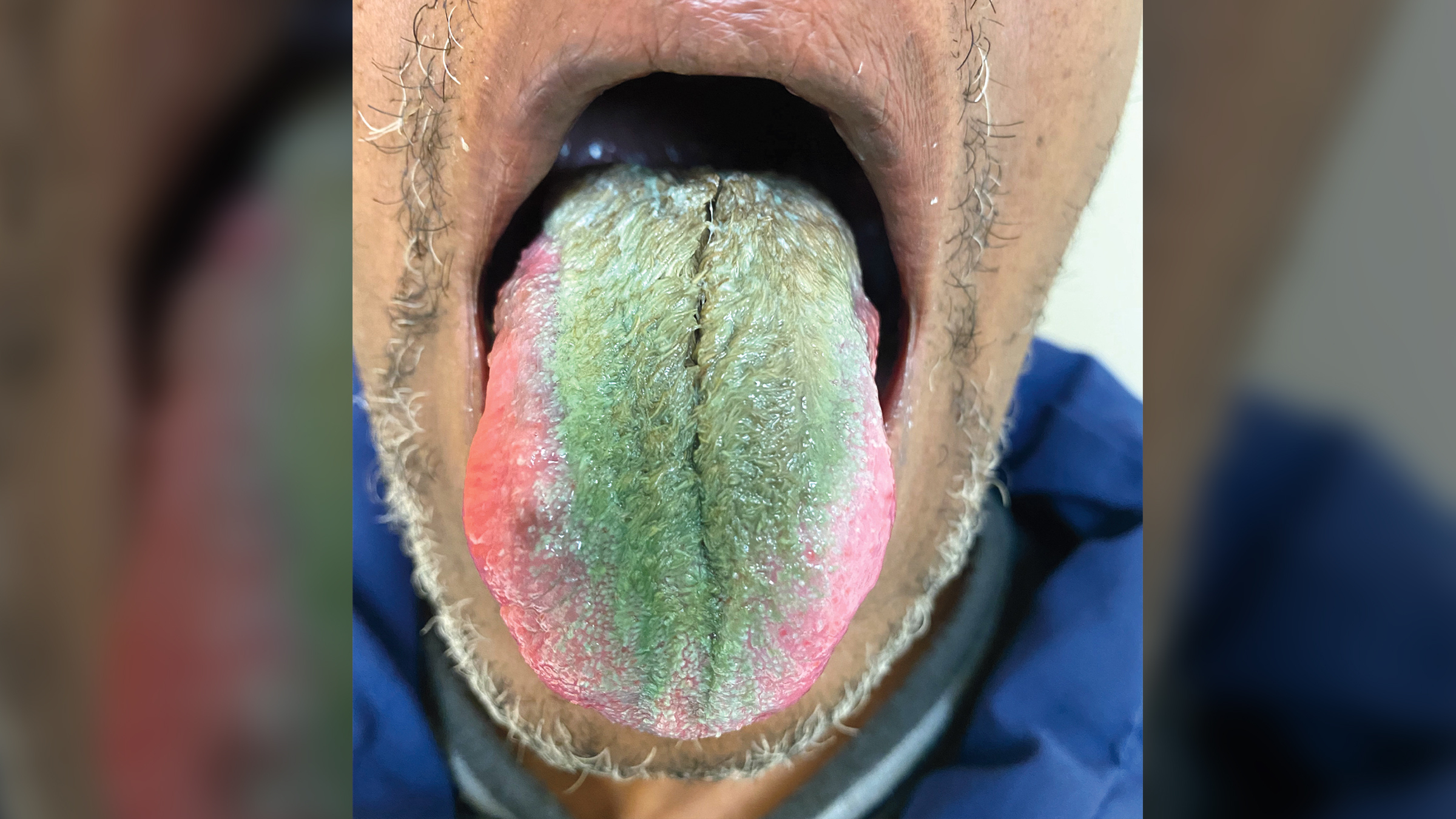
A man found that his tongue was sprouting green "hairs" after he developed a benign condition known as hairy tongue. Lingua villosa, as it is also called, happens when the tiny bumps on the tongue, called papillae, don't shed as they normally would and thus grow beyond their normal length, which is usually around 0.04 inch (1 millimeter) long. As the bumps grow, they turn a particular color — typically green, brown, white, green or pink — depending on the food, bacteria and other material they encounter.
The condition is fairly common, affecting about 13% of people at some point in their lives. Eating soft foods and drinking large amounts of coffee, tea or alcohol can increase the risk of developing hairy tongue. The 64-year-old in this case followed his doctors' instructions to scrub his tongue daily with a toothbrush, and his tongue turned back to normal in six months, the case report noted.
Sign up for the Live Science daily newsletter now
Get the world’s most fascinating discoveries delivered straight to your inbox.
Fetus in a toddler's brain

Doctors surgically removed a fetus that was found in the brain of a 1-year-old girl.
This rare condition, called intraventricular fetus in fetu, was discovered after the child developed an enlarged head and had delayed motor skill development. The fetus came from the same fertilized egg as the girl, so if the fetus had developed normally, it would have been her identical twin. However, when one fetus envelops the other, the absorbed twin typically stops developing.
Fetus-in-fetu is very rare, occurring in only about 1 in 500,000 births. Most cases of the phenomenon happen in the abdomen, rather than the head.
Student able to change pupil size

Most of us can't tell what our pupils are doing, as usually, they automatically dilate in the dark to let in more light and constrict in bright environments to limit the amount of light that flows through them. However, one student in Germany found he could enlarge and shrink his pupils voluntarily.
The 23-year-old told researchers that constricting his pupils felt like tensing something, while making them larger felt like he was fully relaxing his eyes. At first, he changed his pupils' sizes by focusing in front of or behind an object, and then with practice, he learned how to do it simply by concentrating on his eyes. Although some people can achieve this effect indirectly, such as by thinking about the sun, researchers couldn't find any indication that the student was using such a method.
Man living normally with small brain

A 44-year-old man who worked as a civil servant was leading a normal life, despite his brain being at least half the average size.
This case was described in the journal The Lancet after the man sought medical help because he had felt weakness in his left leg for two weeks. When he was 6 months old, doctors had placed a shunt in his head to relieve fluid buildup in his brain. At age 14, he lost full control of his left leg but recovered it after the shunt was altered. His neurological development and the rest of his medical history were otherwise normal.
However, after he sought medical help for the weakness in his leg, brain scans showed several abnormalities. His condition caused a buildup of fluid in his skull, which left him with just a thin sheet of brain tissue, because the fluid left little room for brain tissue. Feeling returned to his leg after a new shunt was inserted to drain the excess fluid.
Teen speaking only in a foreign language

A 17-year-old in the Netherlands lost his ability to speak and understand Dutch for 24 hours after an orthopedic surgery. During this case of foreign language syndrome (FLS), he could communicate only in English, which he'd never spoken outside of a classroom.
According to the case report, it started when the teen went to the hospital for knee surgery following an incident during a soccer game. This was his first time being operated on and undergoing general anesthesia. When he woke up, he was confused and thought he was in the United States, specifically Utah. A psychiatrist confirmed that the teen could answer questions only in English — adequately but not fluently.
When friends came to visit him around 24 hours after the surgery, the boy spontaneously began to understand and speak Dutch again. During a mental exam the next day, the teen said he could remember himself only speaking and understanding English. However, it could be that he thought this because he was told about the incident.
The authors of the case report believe this was the first scientifically reported case of FLS in a child or adolescent. It's unclear what caused the teen to experience FLS, but the authors hypothesized that it might have been linked to the anesthetic he was given.
Severe side effect of holding in a sneeze
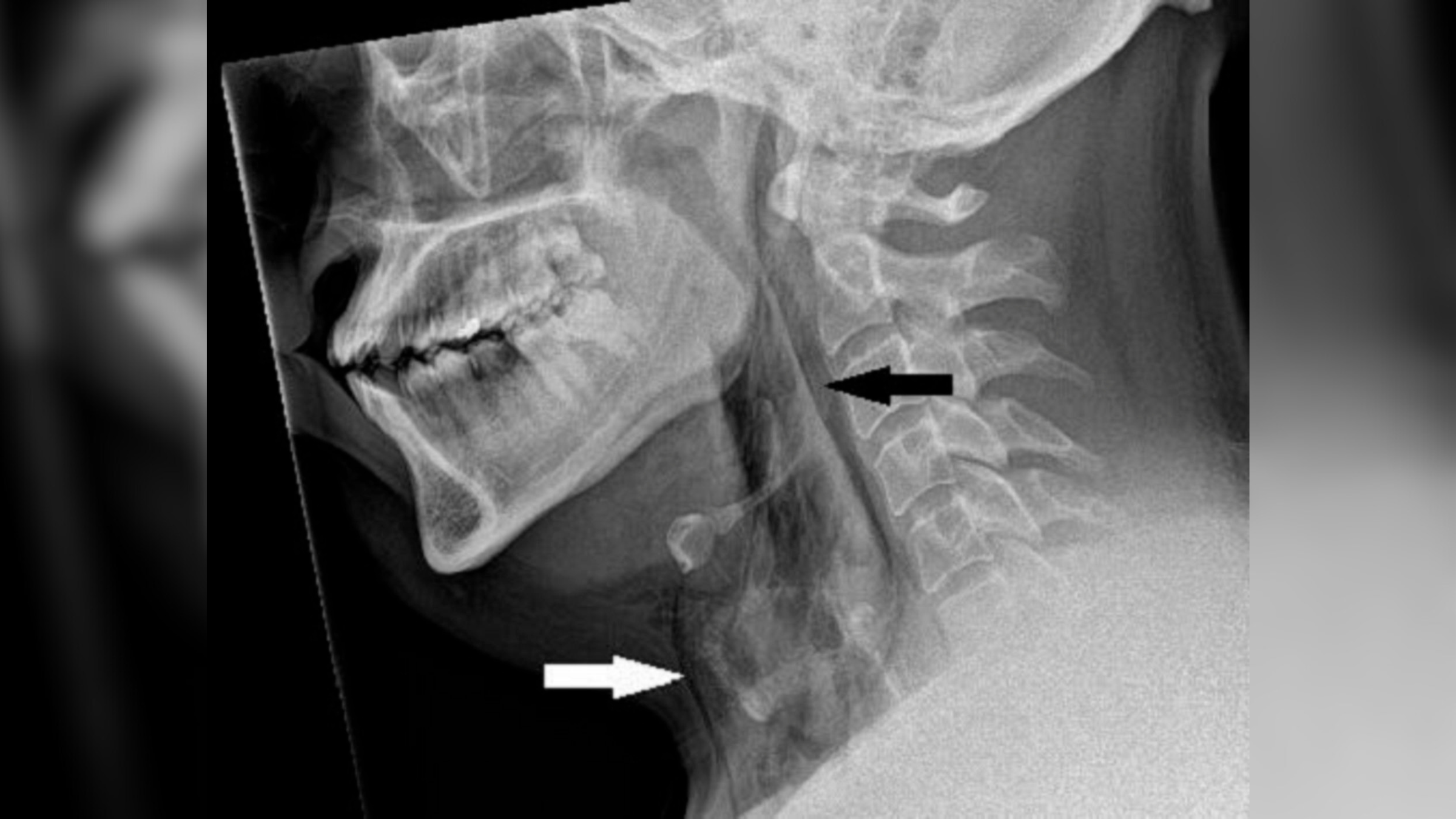
A man in his 30s was driving when he felt the urge to sneeze. He stifled his sneezes by pinching his nose and closing his mouth but immediately felt severe neck pain. When he went to the ER, a CT scan of his neck and chest revealed a quarter-inch-long (half a centimeter) tear in his trachea, or windpipe.
Doctors decided against surgery, since the man's vital signs were otherwise normal. Nevertheless, the patient was kept under observation. Five weeks after he was discharged, a follow-up CT scan showed that his trachea had healed.
"We suspect the trachea perforated due to a rapid build-up of pressure in the trachea while sneezing with a pinched nose and closed mouth," the care team wrote in the journal BMJ Case Reports. They advised people not to stifle sneezes in this way.
Girl born with hair all over her body

Since birth, a 2-year-old girl had hair all over her body, except on her palms, soles, mouth, eyes and nose.
In a report of the case, doctors noted that the girl had no other complications related to the condition, known as congenital generalized hypertrichosis terminalis. The main reason she was brought in for medical attention was that her parents were alarmed by her physical appearance. Doctors assured her parents that the condition was benign and listed some hair-removal options for the child.
Allergy to water

In an extremely rare case, an 18-month-old was diagnosed with an allergy to water, known medically as aquagenic urticaria. Within just 15 seconds of coming into contact with water, she experienced severe skin reactions, including hives and rashes.
The exact cause of this condition remains unknown. Some theories suggest the hives could be caused by a substance that's dissolved in the water, such as chlorine, rather than the water itself, or that something on patients' skin produces a toxic substance when it touches water.
Baby's changing eye color

A 6-month-old's eyes turned from brown to a deep indigo blue after he was given the antiviral favipiravir to treat COVID-19.
Favipiravir stops viruses from replicating their genetic material. Less than a day after the antiviral drug was given to the infant, his eyes started shining blue in the sunlight. A medical examination revealed a buildup of blue pigment in both of his corneas — the clear, outer part of the eye. Five days after the antiviral was stopped, the boy's eyes returned to their original brown.
The blue may have been caused by the buildup of fluorescent chemicals in the cornea as the drug was broken down by the body, the case report authors suggested.
The dancing plague

One of the greatest unsolved mysteries of public health is what caused the three-century-long "dancing plague" in Europe.
Starting in the 13th century, people in Germany, the Netherlands and Italy would reportedly gather in large crowds and dance frantically until they got exhausted or died. As many as 1,100 people would take part in each gathering. There are detailed accounts of such dancing plagues in literature, but the exact cause remains unknown. It's likely that this dancing plague, or choreomania, was triggered by a combination of factors.
Historical accounts suggest that it was a mass psychological phenomenon triggered by social adversity and that it presented itself in the form of dancing due to the underlying culture of the period.
Fatal insomnia

A patient was sleeping only two to three hours a night in a case of fatal familial insomnia (FFI). The 57-year-old man had experienced progressive memory decline for one year before being admitted to the hospital. During the day, he often felt weak and often ended up falling asleep when he was sitting or lying down. His ability to use chopsticks worsened quickly, he developed issues walking soon afterward. The man died a few months after being admitted to the hospital.
FFI is a type of hereditary prion protein disease for which there's no effective treatment. Prion diseases occur when cells make dysfunctional proteins that accumulate in the brain, leading to progressive damage. The symptoms of FFI include insomnia, movement disorders and hormonal shifts. Tests usually reveal mutations in a gene called PRNP; one mutation called D178N is tied to both FFI and a second prion disease.
Police officer who recognized everyone

"Where do I know you from?" a police officer kept asking strangers. The 46-year-old had developed intermittent episodes of anxiety each lasting about 15 seconds; six months after these episodes began, he had a seizure. His MRI results and neurological exam were normal. However, a month after the seizure, he reported new symptoms. In addition to memory problems, he experienced an odd phenomenon: Every person he saw looked familiar.
A case report detailed how the officer's "hyperfamiliarity" also occurred to a lesser extent with faces in photos and on TV, but not with voices. Patients with hyperfamiliarity for faces (HFF) quickly realize that they're mistaken. They usually have lesions on the left hemisphere and temporal lobe of the brain, but the right hemisphere and frontal areas of their brains remain normal.
The left hemisphere is involved in identifying unique facial features, while the right is known to link faces with emotional and personal meaning. Thus, HFF may occur when the left hemisphere is impaired and the right hemisphere overcompensates, leading to a false sense of familiarity. The authors of the report suggested that HFF is more common than suspected, since the vast majority of cases likely go unrecognized.
Giant kidney worm

A young man went to the ER because he couldn't pee and he'd had a fever for two days. His vitals were normal except for a rapid heart rate. Hospital staff placed a catheter and gave the man IV fluids and a combination of drugs. But on his second day in the hospital, the patient found a worm in his urine bag.
The hospital's microbiology department confirmed that the worm — which was red and almost 12 inches (30 cm) long — was the rare parasite Dioctophyma renale. When his urine was analyzed, no traces of the parasite's eggs were found. Although doctors advised against it, the man left the hospital after he had passed the worm.
D. renale is one of the largest known parasitic nematodes. It's found mostly in the kidneys of flesh-eating mammals, like dogs and wolves, which then excrete its eggs in their urine. Humans could get infected by eating raw or undercooked fish or frogs containing the larvae. In this particular case, the patient had eaten raw fish from a lake close to his home. It wasn't the first time he'd passed such worms. In complicated cases, the only treatment is for the infected kidney to be removed.
Related: 32 scary parasitic diseases
Child who ate "everything except food"

In a case report, doctors described how a 7-year-old girl reported to their department with a history of abdominal pain for three years, worn down teeth and cavities. The girl had been eating pieces of bricks for five years, despite warnings from her parents.
It's common for babies to go through a temporary period of putting all kinds of things in their mouths. However, when a child past this phase starts eating things that aren't food again, there's cause for concern. When people start eating nonfood items such as stones, bricks, chalk and soap, the condition is known as pica. Possible causes of pica include iron deficiency and lead exposure.
The child in the case report was given iron, zinc and calcium supplements, and her habit stopped after six months.
Double teeth

When a 14-year-old boy went in for a routine dental checkup, dentists found that his left first premolar had two crowns. He had no symptoms related to the tooth and did not want any treatment for it, according to the report of the case.
Tooth gemination, commonly known as "double teeth," is a development disorder of a tooth's shape coming from a single tooth germ's unsuccessful attempt to divide. The exact cause of gemination is unknown, but environmental factors such as trauma or vitamin deficiencies may play a role.
Mermaid syndrome

A report describes the case of a baby with sirenomelia, also known as "mermaid syndrome," a condition in which a baby is born with a single middle lower limb instead of two legs. The baby was born with fused lower limbs and fused feet, which were rotated and aligned abnormally, making them resemble fins. The baby was transferred to a neonatal unit but died after seven hours of life.
Risk factors for mermaid syndrome include maternal diabetes and drug abuse, but the exact cause remains unknown.
Woman who couldn't feel pain

A 58-year-old woman had a long history of insensitivity to pain and recalled how, as a child, she would get cuts that she could not feel. She also did not feel pain when touching extremely hot or cold water, although she could tell the difference between the two, her doctors described in a case report. The woman, who has two children, didn't feel pain during childbirth, either.
She was diagnosed with a condition called congenital insensitivity to pain (CIP), a rare disease caused by mutations in the SCN9A gene. People who have CIP can feel different sensations but can't perceive pain.
Similar to others with CIP, the woman had anosmia, meaning she couldn't smell.
Persistent hiccups

While hiccups usually end on their own after a short while, that's not always the case. In fact, almost 4,000 people are admitted to the hospital in the United States for hiccups every year.
A 22-year-old male reported having hiccups all day for two years. Past medical treatments, which were not described in the report, did not help. Due to his chronic hiccups, he quit his job and his social life broke down. He also started feeling abdominal pain and had anemia.
Eventually, he chose to undergo surgery to treat his gastroesophageal reflux, which was thought to be causing the hiccups, and he hiccuped throughout the procedure. Although the frequency of his hiccups decreased after the surgery, he wasn't entirely cured. While it's often not possible to identify a single cause for chronic hiccups, some cases include gastroesophageal reflux disease and adrenal insufficiency.
Giant, lung-shaped blood clot
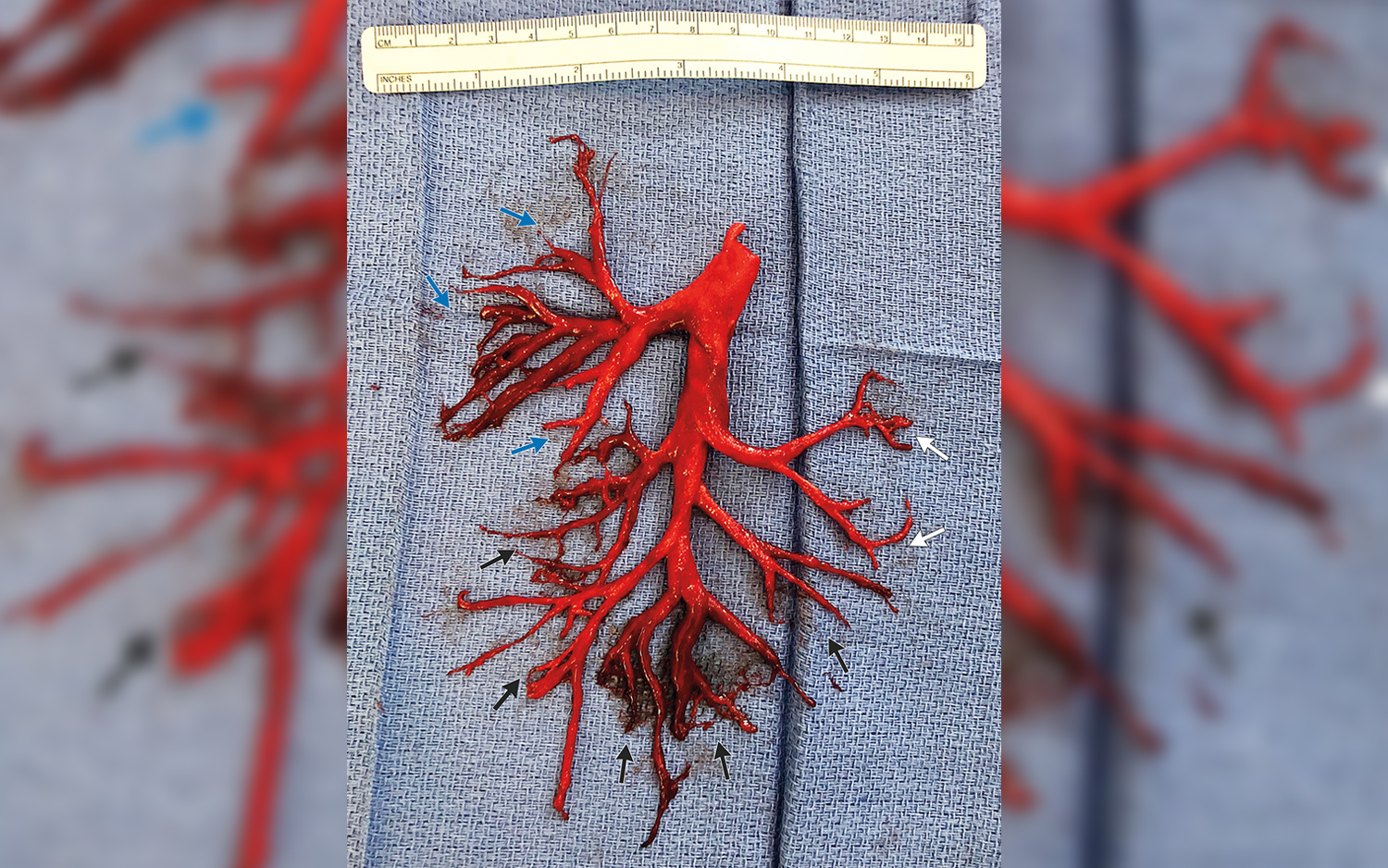
A man was admitted to the intensive care unit when his symptoms of chronic heart failure suddenly worsened. After admission he started coughing up blood and also had trouble breathing. He was given blood-thinning medication, which increased his risk of bleeding, for the serious heart condition. At one point, he started coughing violently — and he hacked up a giant blood clot in the shape of part of his lung. Basically, it was a mold of clotted blood in the shape of a branched airway called a bronchial tree.
The 36-year-old man died a week later due to complications of heart failure. Doctors published the image of the blood clot in a case report in The New England Journal of Medicine.
Navy-blue blood
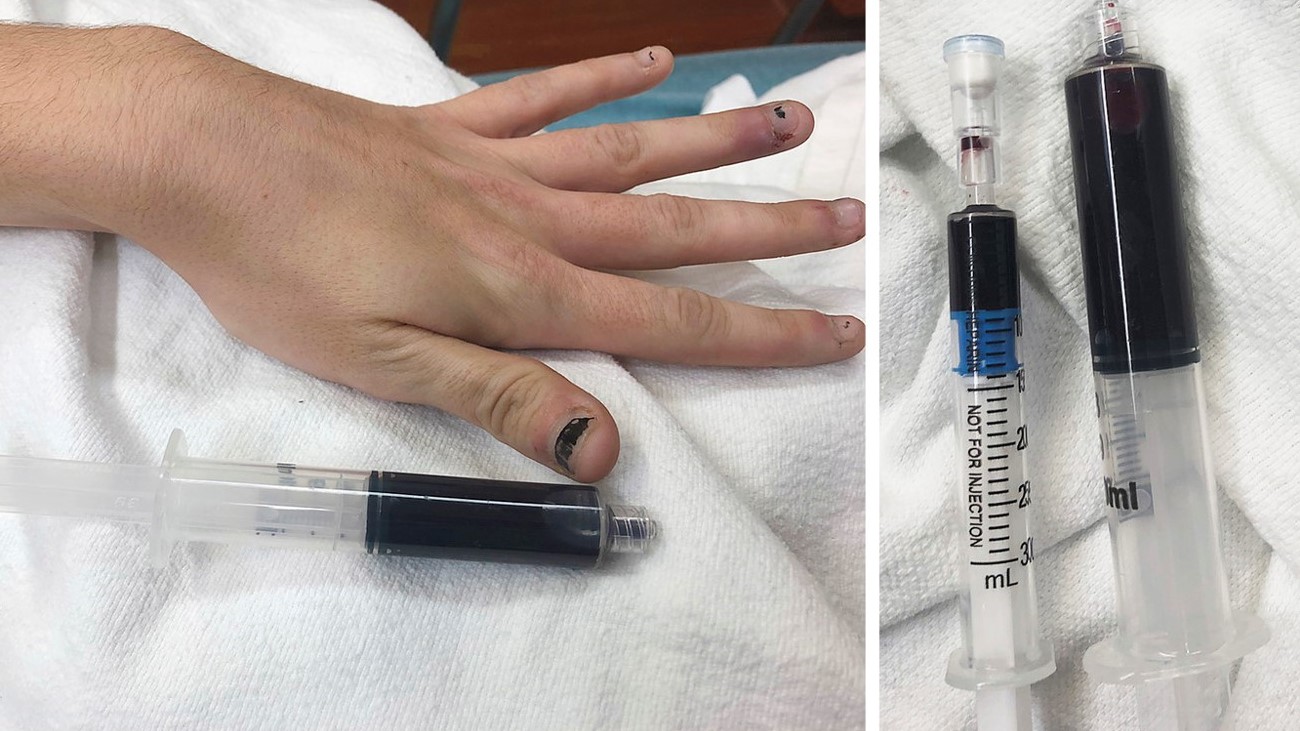
One night, a 25-year-old woman in Rhode Island applied large amounts of numbing medication to a tooth that was hurting her. The next day, she went to the ER because she felt weak and fatigued, was experiencing shortness of breath and had skin discoloration.
When her blood was drawn, it appeared a deep, navy blue instead of red. According to the case report, the woman had a condition called methemoglobinemia, where there's an increased level of a type of hemoglobin called methemoglobin, which, unlike the regular form of hemoglobin, can't carry oxygen to the rest of the body.
The condition can be either congenital or a side effect of some drugs, including some anesthetics. The woman was quickly treated with intravenous methylene blue, which improved her breathing and reduced her skin discoloration. The medication helped by restoring iron to its proper form within her blood, and in this case, the woman made a complete recovery.
Beer-making belly

A man was arrested for "drunk driving" even though he insisted he hadn't been drinking. After this incident, he went to an Ohio clinic, where doctors found strains of Saccharomyces boulardii and Saccharomyces cerevisiae, known as brewer's yeast, in his stool samples.
It turned out that the man had a condition called auto-brewery syndrome, in which microbes in the gut transform carbohydrates into alcohol, according to a case report in the journal BMJ Open Gastroenterology. This diagnosis also explained why he had episodes of mysterious drunkenness and "brain fog." The man was cured after doctors placed him on antifungal agents and a carbohydrate-free diet for six weeks.
Sudoku-triggered seizures

In a puzzling case, a German man developed seizures while trying to solve a Sudoku brainteaser.
According to the report of the man's case, he hadn't always reacted this way to Sudoku. During a ski trip in 2008, he was buried in the snow by an avalanche, knocked unconscious and then given CPR. The man survived, but because his brain was deprived of oxygen for 15 minutes, he developed muscle jerks in his mouth and legs. After being given anti-epileptic medication, he started to recover.
But while trying to solve a Sudoku puzzle at a rehabilitation facility, the man started experiencing involuntary jerking motions, called clonic seizures, in his left arm. Doctors later discovered that the seizures were triggered when the man imagined the numbers in Sudoku grids in three dimensions, which reportedly helped him solve the puzzles. Unfortunately, that put an end to the man's hobby, as it was the only way he could avoid the seizures.
Teeth in a baby's brain
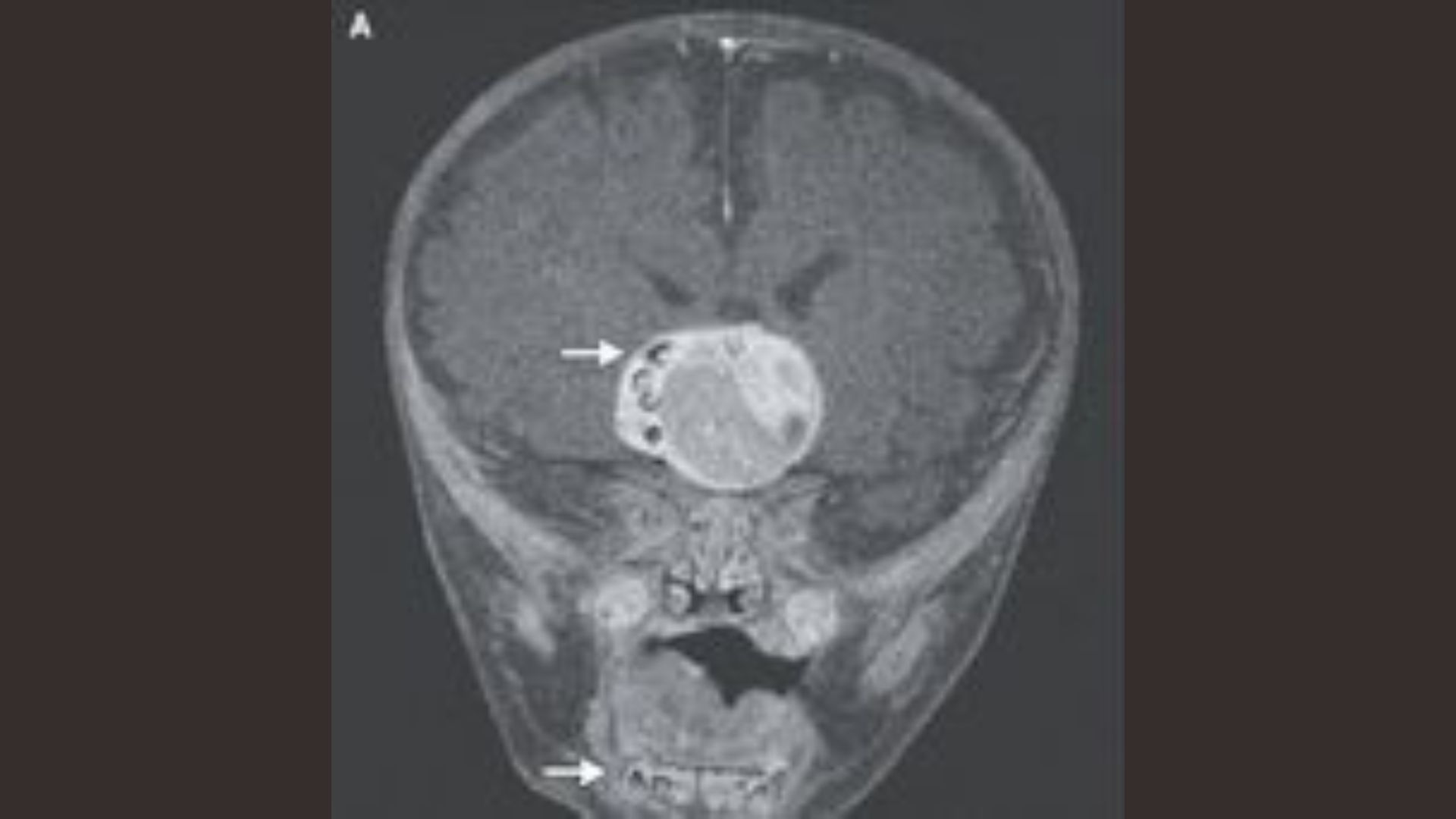
A 4-month-old boy was taken for medical tests because his head appeared to be growing faster than what was normal for his age. A brain scan confirmed that he had a brain tumor. However, during brain surgery to remove the tumor, doctors found that it contained several fully formed teeth, according to the case report.
It turned out that the child had a craniopharyngioma, a rare type of benign brain tumor. After the surgery, his doctor said the boy was "doing extremely well, all things considered."
Long-lost contact lens found decades later

While playing badminton, a 14-year-old girl was hit in the eye with a shuttlecock. She was wearing a contact lens, which she couldn't find; she assumed it fell out of her eye and was lost. However, she was in for a surprise when she went to the doctor due to swelling in her left upper eyelid 28 years later.
An MRI showed a cyst, which was surgically removed. When it was removed, the cyst burst — and there, lo and behold, was the long-lost contact lens, her doctors explained. It turned out that during the badminton injury, the lens migrated to the woman's left upper eyelid, where it remained hidden for 28 years.
Baboon syndrome

Penicillin is one of the most commonly used antibiotics globally, but as with any other drug, it can have side effects. A 40-year-old man with a sore throat was given penicillin to treat tonsillitis. Days later, he developed a rash on his armpits, groin and buttocks in a case of "baboon syndrome," named after its resemblance to the red coloration on the rears of some monkeys.
The condition, formerly called "symmetrical drug-related intertriginous and flexural exanthema," is usually caused by an allergic reaction to penicillin or other substances, such as mercury. According to the man's case report, the rash disappeared after his medication was changed.
Temporary wrinkles
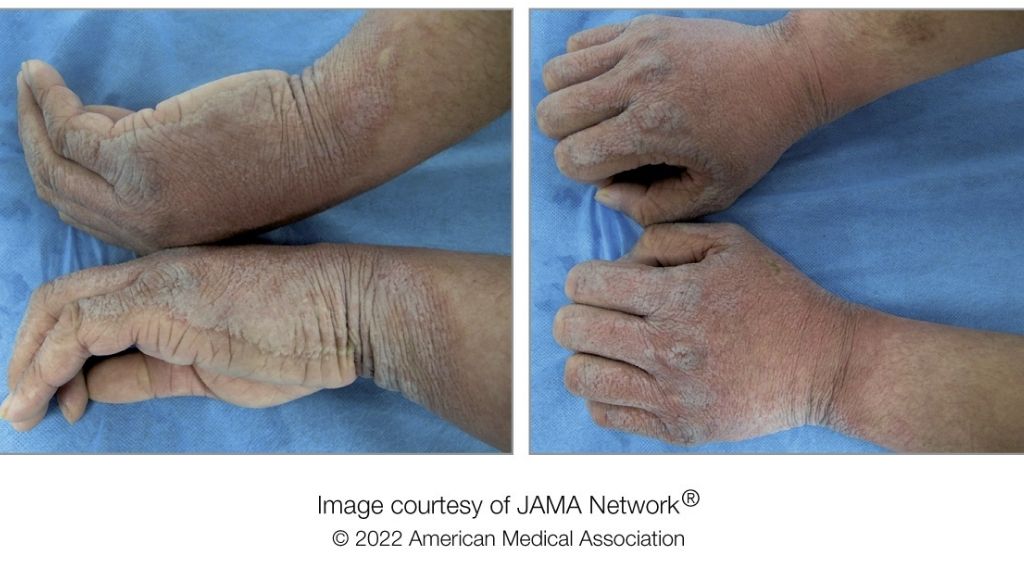
When a man put his hands in water, he developed "excessive wrinkling" on his hands that would disappear around 30 minutes after they dried, according to a case report in the journal JAMA Dermatology.
The condition, called aquagenic syringeal acrokeratoderma (ASA), is a rare skin disease that usually occurs in young women, but in this instance, it affected a man in his 20s. It occurs mostly in people with cystic fibrosis.
The man sought medical help after experiencing the condition for three years, with the skin on his hands becoming swollen, wrinkly and scaly whenever they made contact with water. The man's palms were unaffected, which is unusual, but he was nonetheless diagnosed with ASA. He was treated with an ointment containing a corticosteroid and moisturizer, and his symptoms started improving within a month.
Accidental caffeine overdose after measuring error

An error while measuring caffeine powder had fatal consequences for a man in the U.K. The 29-year-old personal trainer ordered a small bag of caffeine powder to add to his drinks. Although he meant to add up to 300 milligrams (0.01 ounce) of the powder, the scale he used had a starting weight of 2 grams (0.07 oz). Immediately after consuming his drink, he felt his heart beating fast, and he started foaming at the mouth. His wife called an ambulance, but the man died later that day.
At the time, the coroner found a caffeine level of 392 milligrams per liter in the victim's blood — the equivalent of about 100 to 200 cups of coffee. The coroner said it appeared that the man was aiming for the middle of the range of the recommended caffeine dose but got his calculations wrong.
Folded stomach

Doctors managed to save a girl's life after she developed a rare and potentially life-threatening condition called gastric volvulus, in which part or all of the stomach rotates by more than 180 degrees. When this happened to the 12-year-old girl, she was left in crippling pain, could not breathe properly and couldn't pass stools.
Gastric volvulus can lead to an obstructed stomach, blocking the movement of food, blood and oxygen. According to the report of her case, the girl survived, thanks to the prompt diagnosis and surgical treatment. However, the condition is fatal in about 30% to 50% of cases.
Gastric volvulus is usually caused by a hernia, in which part of the stomach pushes into the chest cavity through an opening in the diaphragm. However, in the girl's case, the stomach folded over itself because the ligaments anchoring her stomach in place were loose.
Tumor in "extra" breast

A 63-year-old woman felt painful swelling in her armpit and sought medical help. Doctors saw that she had a mass of tissue, which an ultrasound revealed was an "extra breast." However, doctors also found a spherical tumor growing in one of the milk ducts in the extra breast. The tumor was benign and was successfully removed, according to the patient's case report.
This kind of tumor affects up to 3% of people in their normal breast tissue, but it is not commonly found in extra breast tissue. Polymastia, which refers to having extra breast tissue, is a relatively common condition, affecting up to 6% of females and 3% of males.
Diver's leaky blood vessels

Scuba divers plan their rate of ascent to avoid decompression sickness (DCS), which can be life threatening. DCS happens when dissolved gases in a person's blood form bubbles in a person's bloodstream and tissues. A diver's rapid ascent from a high-pressure environment in the deep sea to the lower pressure at the surface could trigger DCS. Symptoms include joint pain, nausea and headaches.
One diver had an extremely rare complication of DCS in which fluid started flowing out of his cells, doctors explained in the journal BMJ Case Reports. The man, who was in his 40s, went to the ER with shortness of breath after a 100-foot (30 meters) dive. While doctors might have suspected DCS, an expert on systemic capillary leak syndrome (SCLS) identified the diver's symptoms and helped provide the appropriate treatment for the complication.
It was suspected that air bubbles formed in the patient's blood vessels, triggering a "pro-inflammatory cascade which made the vessels more permeable, resulting in the leakage of protein and fluid," the expert said at the time. SCLS can be fatal, but in this case prompt diagnosis and treatment meant the diver was discharged in less than a week.
Locked-in syndrome

A case report describes the case of a 54-year-old man with locked-in syndrome (LIS), a rare neurologic disorder in which patients can't move or speak but can otherwise think normally. It has been described as "being a prisoner in [your] own body."
Historically, people with LIS have interacted with others by moving their eyes or blinking; nowadays, though, there are various assistive devices available and in development to help people communicate. The main cause of LIS is damage to a part of the brain called the ventral pons; the damage most commonly results from a stroke but can also be caused by trauma; infection; masses, such as tumors; or demyelinating disorders, such as multiple sclerosis.
Patients can live for years with LIS. However, this patient had recurrent infections and died from pneumonia 36 days after being diagnosed with the condition.
Christoph Schwaiger is a freelance journalist. His main areas of focus are science, technology and current affairs. His work has appeared in a number of established outlets in various countries. When he's not busy hosting the discussions himself, Schwaiger is also a regular guest on different news programs and shows. He loves being active and is regularly spotted helping out organizations that champion causes that are close to his heart. Schwaiger holds an MA in journalism.











